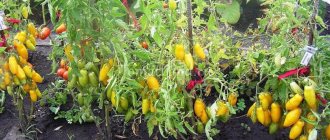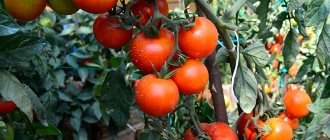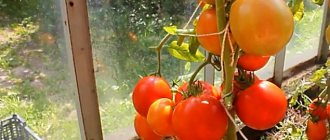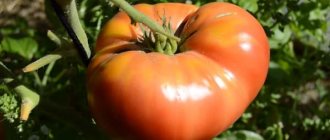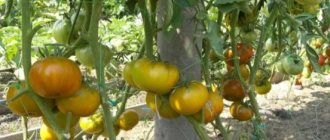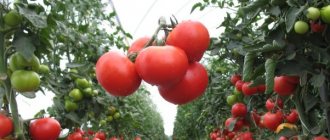Today, many gardeners prefer to grow Bulgarian tomatoes, because they are incredibly tasty. One of the main characters in our market is the Bulgarian tomato, a photo of which has already spread among people who lead a healthy lifestyle. A new variety that has rapidly become famous, it is juicy, nutritious, and a natural antioxidant. Delicious tomatoes are in demand not only in sunny Bulgaria, where tomatoes are included in almost every dish, but also in our country. Therefore, it is worth talking about Bulgarian tomatoes in a little more detail.
Bulgarian tomato varieties: advantages
Why do Bulgarians love tomatoes so much? There are several reasons. Firstly, they are delicious and can add a special, unique flavor to any vegetable dish. Bulgarian cuisine is rich in all kinds of stews, soups and salads, including the traditional lyutenitsa. These dishes always include Bulgarian tomatoes.
Bulgarian varieties are distinguished by their delicate skin and sweetish-sour taste. The peculiarity of Bulgarian tomatoes is also in their appearance.
The advantage of Bulgarian tomatoes is that they are healthy
The tomatoes are elongated (not often found round), smooth. The color of tomatoes is orange, so they can be recognized immediately. The second point is the health benefits. Many people say that what is healthy is rarely tasty. But it is not correct to think so, because American experts have proven that tomato is the healthiest food product.
The benefit lies in the presence of 3 types of antioxidants in the Bulgarian tomato:
- Vitamin C. Without this vitamin, the human body cannot function fully. It provides protection against scurvy and strengthens the immune system.
- Lycopene. The antioxidant effectively cleanses the blood of free radicals: toxic substances that are one of the main factors of rapid aging.
- B-carotene. Tomatoes hold the record for the content of this useful substance. A form of vitamin A keeps vision healthy.
Bulgarian tomatoes differ from other types of tomatoes in their double content of antioxidants, which immediately includes them in the every day menu of every gourmet involved in a healthy diet. Tomatoes also bring benefits to children's bodies. Officially, the variety is called Plovdiv carotene, as it was bred and studied by workers at the Maritsa Institute of Vegetable Growing, which is located in the city of Plovdiv.
It is interesting that at the same time the largest agricultural company in Europe was collaborating with Bulgaria, which introduced the latest innovations and controlled the development of new varieties, based on which there can be no doubt about the high quality. The same union provided assistance with the promotion and supply of new tomatoes to a large number of countries, including Russia.
Sweet and sour marinade recipe
Not everyone loves classic canned tomatoes. Recipes with the addition of horseradish and granulated sugar will help make them more original.
Ingredients:
- 1.5 kilograms of tomatoes;
- dill umbrellas;
- horseradish 80 g;
- currant leaves 5-8 pieces;
- 1 horseradish leaves;
- garlic 4-5 cloves;
- peppercorns 8-10 pieces;
- green hot pepper, a couple of pods;
- cold water (at least 1.7 l);
- 6% acetic acid tablespoon;
- granulated sugar 3 tablespoons;
- table salt 1.5 tablespoons.
The specified amount of spices is suitable for preparing 1.7 liters of brine. The volume of vegetables may exceed the specified amount if they are small in size.
- Greens and vegetables are washed in advance under running water. Hot pepper, horseradish leaf and root are cut into pieces to distribute evenly among the jars
- Three-liter jars are sterilized over steam or in the oven. For small portions, several liter jars are suitable. The first to be laid are greens, aromatic herbs, peppers and horseradish. Vegetables are compacted on top.
- The prepared vegetables are poured with boiling water and left for 15 minutes. After the allotted time, the water is poured out and acetic acid is added to the jars.
- Add salt and sugar to boiling water (1.7 liters) and leave to boil. Hot brine is poured into jars. Close with sterilized lids.
- Canned tomatoes are left to cool under a warm blanket. Cooled cans are stored in the basement.
The taste of pickled tomato with pepper and sugar is lightly sweet and spicy.
Bulgarian marinated tomatoes are prepared in a variety of ways. To obtain a balanced taste and lower costs, it is recommended to use ready-made pickling seasoning. It contains all the necessary spices.
If you come from the USSR, you probably remember the taste and aroma of Bulgarian tomatoes. You open the jar for the holiday, but already in the process of setting the table you won’t be able to resist trying the treasured tomato. And what a beauty - small, smooth tomatoes in a clear marinade with umbrellas of dill and cloves of garlic!
I suggest preparing Bulgarian-style tomatoes at home for the winter, I guarantee you the most delicious recipe.
A small note: to prepare the marinade, I bought a ready-made package of “Seasoning for pickling and pickling tomatoes.” All the best dry ingredients are included in the package. But you can collect the dry component yourself, adjusting the amount of one or another dry seasoning to taste and desire. For example, not everyone likes spicy cloves - limit the number of stars to 1-2 pieces; dry ginger is generally not an acquired taste - I just threw it out of the marinade. It is advisable to choose garlic for the marinade not young, but mature and always undamaged. Good luck with your preparation!
for a 1 liter jar: - cream tomatoes - 1 kg, - dill umbrellas - 5-6 pcs., - garlic - 1-2 cloves.
Marinade:
- boiling water - 1 liter, - salt - 2.5 tsp, - sugar - 3 tsp.
without a slide, - table vinegar 9% - 5 tbsp., - seasoning for pickling. Soak cream tomatoes in cold water for 15 minutes. Wash well under running water. Pierce each tomato lengthwise with a wooden skewer. This must be done so that the tomatoes remain intact when pouring hot water and marinade. Place several dill umbrellas in the bottom of a sterilized jar. Then start laying the tomato. Fill the jar with tomatoes to the very top as tightly as possible, but without damaging the cream itself. Fill the tomatoes in the jar with boiling water (no spices!) to the very top. Cover the jar with a lid and leave the tomatoes in hot water for 15 minutes. At this time, prepare the dry part of the marinade: pour salt, sugar and spices into a bowl/saucepan. For the marinade, I used dry seasoning for pickling and pickling tomatoes, which included black pepper, allspice, dry cloves, bay leaf, mustard seeds and dry ginger. Then put a lid with holes on the jar of tomatoes in boiling water to drain the liquid. Carefully pour the water into a bowl/saucepan with the dry component of the marinade. Cook the marinade for 2 minutes after boiling. Remove from heat, add table vinegar to the hot marinade and stir. Add 1-2 cloves of garlic, cut lengthwise, into the jar of tomatoes. Pour the hot marinade over the cream to the very top. Cover the jar with a hot lid and quickly close/tighten. Immediately turn the jar of tomatoes in the marinade upside down and wrap it in a warm cloth until it cools completely. The appetizer is very tasty - pickled beets in Bulgarian style. Store ready-made Bulgarian tomatoes in a dark and cool place for the winter. But if there is no such place in your apartment, store it in the refrigerator to fully guarantee the safety of the workpiece until the New Year and beyond. Bulgarian tomatoes in a clear marinade will remain beautiful and intact throughout the entire shelf life. Easy preparation for you and bon appetit!
There is no tastier pickling recipe than Bulgarian tomatoes
: fruits can be prepared in glass jars, combined with other whole fruits, or prepared savory salads for the winter that will diversify your winter diet, where there are not enough fresh vegetables. We are very familiar with the combination of tomatoes and bell peppers, not only in the form of fresh summer salads, but also as one of the most popular options.
Varieties of Bulgarian tomatoes
The most popular variety in our country is the Bulgarian miracle. The tomato variety is high-yielding; it is recommended to grow it in a greenhouse structure in the middle zone, and in the south they can be planted in open ground. The height of seedlings is usually approximately 200 cm. They must be pinched and pruned.
The fruits are flat-round in shape, similar to boats, weigh 400-700 grams, but with proper care it is possible to get very large fruits weighing up to 1 kg.
Before you start growing Bulgarian tomatoes, you should first familiarize yourself with their varieties
To do this, you need to grow bushes from just 1 stem, keeping track of the normal number of ovaries. Tomatoes have a pinkish-raspberry skin that hides dense, fleshy, aromatic and juicy pulp. Such tomatoes can be used to prepare salads, and they also produce thick, healthy tomato juice with a beautiful raspberry color.
Bulgarian Miracle tomatoes have a unique taste and are highly valued by gardeners. Bulgarian Miracle tomato juice is known for its beneficial qualities and authentic taste, especially pleasant in the summer heat, when you really want to quench your thirst. Not so long ago, European concentrates were imported to Bulgaria for juice production, which, understandably, could not guarantee the quality and environmental friendliness of the finished product.
Planting and care
All of the tomatoes listed are grown through seedlings. Work in the central regions begins in the second ten days of March, if they plan to grow them in a greenhouse. For open ground, the deadlines are shifted to the end of the month.
Tomato seeds of the Pearl series are sown in containers with moistened soil in grooves to a depth of about 0.5-1.0 cm. Sprinkle with peat and moisten. Before emergence, containers covered with film or glass are stored in a warm room. Then the seedlings are placed in a well-lit place. When 2-4 true leaves appear, pick them out in separate cups.
Tomato juice from Bulgarian tomatoes
Today, private owners have joined the production of tomato juice, and from Bulgarian tomatoes they make a natural product that is guaranteed to be of high quality and healthy. All laboratory tests confirmed the quality of the product, as they were carried out officially. The heat treatment that tomatoes undergo during juice production enhances the effect of antioxidants. After this, tomato juice becomes even more beneficial than if you eat fresh fruits. Its healing effects affect the entire body in the best way.
The juice in cans, which is prepared from Bulgarian tomatoes, is very tasty and healthy.
Tomato juice:
- Stimulates the functioning of the gastrointestinal tract.
- Strengthens the immune system.
- Reduces the risk of developing a malignant tumor.
- Cleanses blood vessels and the body, in general, from deposits of animal fats.
- Increases the elasticity of arteries.
- Strengthening bones.
- Reduces the risk of osteoporosis.
Bulgarian tomatoes have become a real discovery for those who lead a healthy lifestyle. It is only important to understand that in addition to eating tomatoes, you also need to give up junk food and alcohol.
How to choose Bulgarian tomato seeds
Tomato is one of the most popular vegetables these days. In most countries, the tomato is the 2nd most commonly eaten vegetable after the potato. Absolutely all gardeners plant tomatoes. Today, the supply of various varieties of tomatoes is at the highest level. There are varieties of tomatoes for garden beds, some for greenhouses, and some that can be grown on the balcony and even at home.
When choosing a variety of seeds for growing tomatoes, you must pay attention to their characteristics
There are varieties of giants and tiny ones, of very different colors:
- Red;
- Yellow;
- Black;
- Pink.
There is a whole tomato paradise on the market. For example, any agricultural company can offer customers at least 70 varieties of tomatoes. There is plenty to choose from, but how not to make a mistake and choose seeds for yourself that will give a bountiful harvest. How to understand which seeds are right for you. The final choice of suitable tomato varieties or hybrids will come over time. But you have to start somewhere. And you should start with the most basic – with the classification of varieties and proper sowing of seeds. And as a result of growing high-quality seedlings.
All varieties of tomatoes are divided into early-ripening, mid-ripening and late-ripening varieties. Early ripening ones will ripen in mid-summer.
Mid-season varieties will ripen only at the end of summer, in early September. Well, late-ripening ones will ripen by the end of September. Also, professional gardeners advise growing early-ripening varieties in open ground, and early-ripening and mid-ripening tomatoes in greenhouses. The choice of variety depends on what the ripe fruits are needed for, and the purposes can be varied. It is clear that the first crop of tomatoes harvested in mid-summer will most likely be used for preparing salads and other dishes. Mid-season ones can also be used for preparing salads, and they are also suitable for preservation for the winter.
Diseases and pests
The tomato varieties described above are resistant to most diseases. However, preventive treatment of plants against late blight will not hurt. A terrible disease can destroy the entire crop. First, yellow or black spots appear on the leaves. Gradually, the fungus spreads to the fruits, which begin to rot. Tomato bushes are sprayed with a solution of phytosporin or copper-containing preparations several times a season.
Of the pests, the most dangerous are mole crickets that damage the root system. To avoid insect invasion, plantings are regularly loosened, weeds are removed, and the beds are kept clean. It is not recommended to add fresh manure to the soil.



